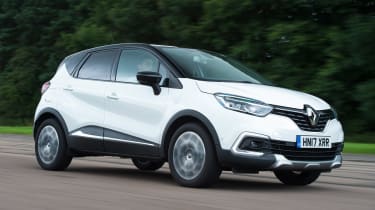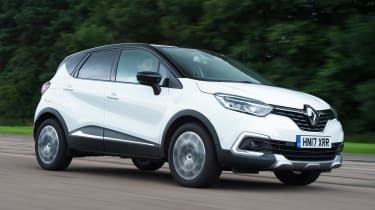At the top of the range is the £28k Esprit Alpine , which is only available with the hybrid powertrain. It adds 19-inch alloys, adaptive cruise control, electrically adjustable and heated front seats, a heated steering wheel, and a unique interior combination of synthetic leather and fabric trim.
The Esprit Alpine also features a range of outside styling enhancements, including a dual-tone paint finish, Alpine badging, and dark grey exterior trim elements.
The Renault Captur is available with two powertrains, and both have their strong points. The base-level 1.0-litre three-cylinder opens up the range and is a cost-effective option, but Renault’s clever E-Tech hybrid system offers some notable improvements in efficiency, performance and refinement. Read more about the Renault Captur’s engine, performance and drive…
On the official WLTP cycle, the base TCe 90 is rated at 47.9mpg, with CO2 at 134g/km, both competitive figures for the class. The hybrid, however, does have tangible improvements in efficiency and therefore running costs. It’s rated at 60.1mpg and 105g/km – close to the top of the class. Read more about the Renault Captur’s MPG, C02 and running costs…
Times are moving quickly in terms of interior design and tech and this is where the Captur’s relative age shows. Renault has made lots of effort to keep the cabin sharp with new high-res displays and more contemporary-looking colour and trim elements, but the cabin still looks and feels a little off the pace. Read more about the Renault Captur’s interior, design and technology…
Upright proportions help keep the Captur feeling spacious inside, and a clever sliding second row allows the driver to choose the compromise between rear legroom and boot space. Comfort is generally good, but high-spec models and their big wheels can affect ride quality. Read more about the Renault Captur’s boot space, comfort and practicality…
The Renault Captur features all the active safety systems you’d expect of a modern small SUV, but a retest in 2024 by safety experts Euro NCAP under tougher criteria has meant its previous five-star result in 2019 has dropped to four stars out of five. In terms of reliability, though, the French brand hasn’t scores as well as Japanese or Korean alternatives. Read more about the Renault Captur’s reliability and safety…
Renault Captur alternatives
Renault is one of a number of manufacturers battling for sales in the small SUV class. There’s the premium and tech-laden Peugeot 2008, the fun-handling Ford Puma, and three VW Group rivals in the shape of the Skoda Kamiq, SEAT Arona and VW T-Cross. There’s also the leftfield Fiat 600 and the closely related Jeep Avenger, along with a range of Japanese alternatives, including the Nissan Juke (which shares the same platform with the Captur), Toyota Yaris Cross, Honda HR-V, not forgetting tech-forward Hyundai Kona and Kia Niro options from South Korea.
Used and nearly new
The Mk1 Renault Captur has been around since 2013, but the current model takes its basis from the Mk2 launched in 2020. There’s plenty of choice for buyers seeking a used example with a particular engine/trim combination. You’ll notice the cheaper feeling interior and dated tech in early cars, but if you’re looking for a good-looking compact crossover that offers decent space and is easy to drive, the Captur should be of interest.
Renault Captur history
Renault Captur Mk1: 2013-2019

As one of the first entrants in the small SUV segment back in 2013, the Renault Captur was quick to find an audience looking for a supermini footprint combined with the added practicality and versatility of an SUV. Today, all of Renault’s key rivals have an offering of this size, creating a marketplace full of competitive rivals.
The small SUV class is aimed at the growing family looking for style, space and plenty of safety kit. Renault has ticked all three boxes, but particularly the latter, as all models feature a host of equipment designed to protect the driver, passengers and pedestrians out on the road.
The 2024 facelift of the Mk2 Captur, that originally launched in 2019, introduced a new look, featuring a wider grille and LED lights at the front and rear, helping it to cut a more impressive figure on the road. Customers that wish to really stand out from the crowd are well catered for, too, with a choice of six exterior body colours with or without a contrasting black roof.
Frequently Asked Questions
The Captur has a fairly standard three-year/60,000-mile warranty, which is slightly shorter than the 3yr/100,000-mile cover for Renault’s EVs. The mileage limit for the Captur is unlimited in the first two years, though.


